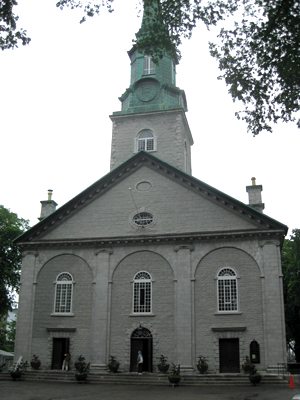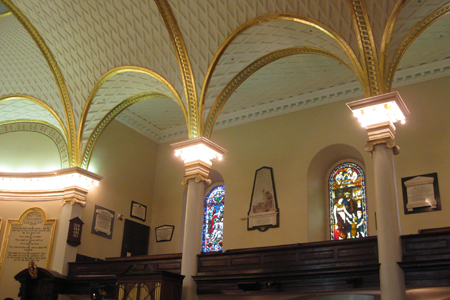| |
 |
 |
 |
| Comment on this report, or find other reports. |
 |
| Our Mystery Worshippers are volunteers who warm church pews for us around the world. If you'd like to become a Mystery Worshipper, start here. |
 |
| Find out how to reproduce this report in your church magazine or website. |
|
|
| 1757: Cathedral
of the Holy Trinity, Québec City, Canada |
 |
 |
 |
Mystery Worshipper:
Kingsfold.
The church:
Cathedral of the
Holy Trinity, Québec City, Canada.
Denomination:
Anglican
Church of Canada, Diocese
of Québec.
The building:
Holy Trinity was built between 1800 and 1804, and is the first
Anglican cathedral to be built outside the British Isles. Built
of a local grey stone, it was designed by two Royal Artillery
officers (Major William Robe and Captain William Hall) and adapted
from the style of St Martin-in-the-Fields, London. Inside, the
box pews are arranged in two main blocks between the central
aisle of the nave and the two side aisles. These side aisles
are loaded with memorials, many to military or government personnel.
There is also a balcony round three sides of the church, with
the organ occupying the west end of the balcony. The east window
is Palladian in style, with three Victorian stained glass panes
framed in dark wood. The panels of the window were made by Clutterbuck
& Co in England, and were shipped to Québec in barrels of molasses
to protect the glass during the sea voyage. The sanctuary is
semi-circular and painted cream, with panels of the Lord's Prayer
and Creed on the north, and the Ten Commandments on the south.
Over the window is a painted border framing the words Holy Holy
Holy.
The church:
The cathedral is home to two communities of worshippers: the
English-speaking Parish of Québec, made up of Anglican and Lutheran
Christians, and La Paroisse de Tous les Saints, which is the
Francophone parish. They are served by different clergy, and
separate services are held in French and English on a Sunday
morning.
The neighbourhood:
Holy Trinity Cathedral is located in the centre of Vieux-Québec,
one block away from the Catholic Basilica-Cathedral of Notre-Dame
de Québec. The east end of the cathedral faces the Place d'Armes,
which overlooks the St Lawrence River and the funicular railway
down to Basse-Ville (the lower town). Also facing the Place
d'Armes is the Chateau Frontenac, the main landmark of Québec
City, which is now a hotel. Along the north side of the church,
the street is full of small hotels and cafes with their tables
spilling out onto the pavement. The churchyard on the north
side has a path with small arts and craft stalls on either side
displaying a wide variety of goods – mosaics, leather, wood,
jewellery, glass, etc.
The cast:
The celebrant and preacher was the Very Revd Christian Schreiner,
dean of the cathedral and rector of the Parish of Québec. The
choir director was Béatrice Cadrin.
The date & time:
Sunday, 5 July 2009, 11.00am.
What was the name of the service?
Choral Eucharist.
How full was the building?
I'd guess there were around 70 people – enough that the church
neither looked empty nor especially full. It was the English
speaking congregation that I visited (though a number of the
prayers were said in French instead of English) and this appeared
to be comprised of a range of ages and nationalities. I imagine
too that a fair number of the congregation that morning were
visitors like me.
Did anyone welcome you
personally?
The gentleman on the door welcomed me and handed me my book/leaflets. He then went back to his conversation with the folk immediately in front of me about where they had come from whilst I slipped quietly into my pew.
Was your pew comfortable?
For rigid upright box pews, they were considerably more comfortable
than I had anticipated: indeed, I wasn't aware of any particular
discomfort at any point.
How would you describe the pre-service
atmosphere?
Pretty relaxed, with a quiet hum of conversation. The dean walked
down the central nave greeting folk on either side whilst the
organ played in the background. He was about a third to halfway
down the nave when the organ stopped, so he just turned and
walked back to the front in order to greet us formally and begin
the service.
What were the exact opening words of the
service?
"Good morning and welcome" in English and then in
French.
What books did the congregation use during the
service?
The hymn book was Common Praise, Anglican Church of Canada.
There were also two leaflets, the service sheet for the day
and another page containing the words of Eucharistic Prayer
4.
What musical instruments were played?
The organ.

Did anything distract you?
The decoration on the celebrant's chasuble, which from afar
looked like embroidery but turned out to be beading on closer
inspection. However, I spotted this and did a double take just
as he was about to hand me the consecrated bread, which meant
that I really wasn't concentrating on things spiritual!
Was the worship stiff-upper-lip, happy clappy, or
what?
It was middle of the road, done unstuffily and without overmuch
ceremony. This may have been atypical, as the dean did say at
the start of the service that they try to shorten things over
the summer, and cut out the processions.
Exactly how long was the sermon?
12 minutes.
On a scale of 1-10, how
good was the preacher?
7 – I was conscious that the dean was preaching in his
second or third tongue – he is German, but also speaks
French and English – but his delivery was easy and fluent. He
also came across as humble (despite his comments about being
unwilling to ask others for help!) and very genuine.
In a nutshell, what was
the sermon about?
The gospel for the day was Mark 6:1-13, telling how Jesus was
rejected in his home town. Dean Schreiner related a similar
experience of his when he had preached in his home town in Bavaria,
and people were so surprised to see someone in the pulpit whom
they had known growing up that they didn't listen to his message.
However, he went on to say that the biblical passage was not
just about rejection of God's prophet, but also rejection of
God himself. We are perhaps unwilling to accept God because
of our need to be in control of our lives. This comes about
because we live in the world, which teaches us to hide our weakness
and vulnerability so that we build ourselves up and remain in
control. This, he said, is not true: it is the voice of the
serpent. He then related a couple of anecdotes about his own
unwillingness to show weakness and ask others for help in everyday
situations. However, when he admitted his weakness and asked
for help, not only was the task achieved much quicker, but the
person who was helping was given the gift of happiness. And
so it is with God. We need to admit our weakness and our need
of God, because that admission enables us to receive strength
from God and from others.
Which part of the service was like being in
heaven?
The eucharistic prayer was set to a Byzantine tone, chanted
throughout with a sung congregational response. I'm an absolute
sucker for Byzantine tone and harmony, so it was great to hear.
And which part was like being in... er... the other place?
The communion wine was truly revolting. I'm ashamed to have
to call it hellish, but it's very difficult to feel thankful
for the gift you've just received when you're frantically trying
to get the taste of it out of your mouth. Miserere mei Deus.
What happened when you
hung around after the service looking lost?
I hung around a bit trying to get a good photo of the east end,
then made my way back up the aisle, where I was intercepted
by the welcomer past whom I'd slipped earlier. He'd recognised
that he hadn't asked me where I'd come from when I arrived,
and had come to make up for that. After a brief conversation
with him, I went over to the coffee table and helped myself.
There, another member of the congregation asked where I'd come
from and whether I was here on holiday. A gentleman wandered
in dressed in what seemed to be a military costume dating from
the mid 18th century. He was obviously a member of the congregation,
as he greeted many of the people present. It was a little difficult
not to stare!
How would you describe
the after-service coffee?
The coffee was hot but otherwise unmemorable. I think juice
was also available, but I don't remember any tea.
How would you feel about
making this church your regular (where 10 = ecstatic, 0 = terminal)?
7 – This is the heart of Francophone Canada, and Anglican
churches are relatively few and far between. To be honest, I
think that if I lived in Québec, I wouldn't have any other choice
but to worship here. That said, I think I would probably be
quite content at All Saints.
Did the service make you
feel glad to be a Christian?
No, but that's more a reflection of my personal state of mind
at the moment than a result of anything that did or didn't happen
during the service.
What one thing will you remember about all this in seven days' time?
The gentleman in military costume. |
|
|
 |
 |
 |
| We rely on voluntary donations to stay online. If you're a regular visitor to Ship of Fools, please consider supporting us. |
 |
 |
 |
| The Mystery Pilgrim |
 |
| One of our most seasoned reporters makes the Camino pilgrimage to Santiago de Compostela in Spain. Read here. |
 |
 |
 |
| London churches |
 |
| Read reports from 70 London churches, visited by a small army of Mystery Worshippers on one single Sunday. Read here. |
| |
|
|
|
|


